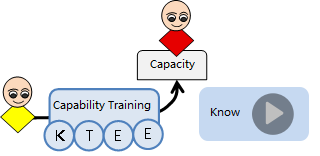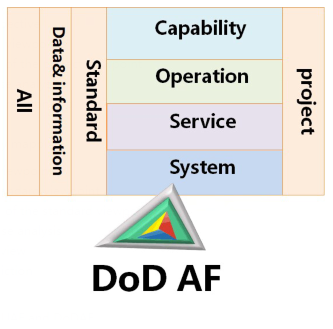|
|
| Successful Case
|
| Continental Automotive Electronics |
| Bosch Automotive Electronics |
| Schaeffler electric drive |
| Joyson Automotive Electronics |
| Huawei Technical Center |
| BMW Automotive Research and Development Center |
| Geely Auto Research Institute |
| Byd Automotive Research Institute |
| |
|
|
|
|
|
|
| Courses > Modeling |
|
 |
|
DoDAF Specifications, Models and Examples |
Views 
|
|
|
| Time Location: Beijing, October 30-31; Shenzhen and Shenzhen open classes Based on registration |
| Course Cost’╝Ü1400 $/Person
|
|
|
|
|
| Internal Training: You can customize internal training according to the needs of the enterprise. |
|
 |
Authentication Method:
Understand the competency model before training.
Ability evaluation after training:
Online Examination
Ability Analysis, give learning suggestions
The qualified person shall be issued a certificate as proof of vocational skill qualification
|
 |
|
|
|
The DoDAF is a system Architecture Framework developed by the U.S. Department of Defense to guide and regulate the systematization and informationization of the U.S. military. DODAF can be used as a reference blueprint for the system architecture design of military informatization, comprehensively considering many aspects such as business, data, application, technology, standards, and project implementation. In order to carry out top-level design for large-scale and complex systems, and guide future system construction. The eight views of DODAF can provide a roadmap and modeling framework for the analysis and design of complex military systems in an all-round and whole-process manner.
This course will explain the overall design process of the DoDAF architecture with a complete example, allowing participants to understand the relevant methods, modeling, and operational roadmap. |
 |
| |
| Training Goal |
- 1. Master the basic framework of DODAF.
2. Learn various viewpoints and models of DODAF
3. Learn the development and modeling methods of various perspectives of DODAF
4. Learn UPDM modeling framework and standards
5. Learn how to implement DODAF with UAF
6. Master the development process and methods of the architecture and apply them to practice.
|
| Training Target’╝ÜChief Engineer, Architect, System Architect and Software Architect of Various military units |
| Student Foundation: Basic understanding of DoDAF |
| Teaching Method:
Customized Course + Case Explanation + Group Discussion, 60% Case Explanation, 40% practice exercise |
| Training Content: 2 Days
|
DoDAF and Architecture Introduction
|
What is DoDAF
Relationship between DoDAF and architecture
What does DoDAF have
DoDAF and MoDAF and UPDM differences and connections
Relationship between DoDAF, UPDM, and UAF
DoDAF's current application in the military industry |
| DoDAF Foundation |
What views do DoDAF have
Why do you need these views
What elements are in these views
The relationship between these views
|
| DoDAF Modeling Basics |
DoDAF modeling specifications that can be adopted
The elements modeled for each view
The relationship between the individual views modeled
Mapping between individual view models |
| Panoramic View |
What is a panoramic view
Why do I need a panoramic view
What are the contents of the panoramic view
Panoramic view case analysis
AV-1: Summary information
AV-2: Integrated dictionary
|
| Capability Perspective |
What is the capability perspective
Why do I need a capability perspective
What are the contents of the capability perspective
Ability perspective case analysis
CV-1: Capability Vision
CV-2: Capability classification
CV-3: Capability stage
CV-4: Capability dependent
CV-5: Capability - Organization Development mapping
CV-6: Capability - Operational Mapping
CV-7: capability-service mapping |
| Operational Viewpoints and Models of DoDAF |
What is the operational viewpoint
Why do we need a combat viewpoint
What are the contents of the combat view
Case analysis of combat viewpoint
OV-1: High level operational concept map
OV-2: Combat resource flow description
OV-3: Combat resource flow matrix
OV-4: Organization relationship diagram
OV-5a: Combat activity decomposition tree
OV-5b: Combat activity model
OV-6a: Combat rules model
OV-6b: Combat state transition model
OV-6c: Operational incident tracking description
DIV-1: Conceptual data model
DIV-2: Logical data model |
| System Viewpoint and Model of DoDAF |
What is a system viewpoint
Why do I need a system viewpoint
What are the contents of the system viewpoint
System view case analysis
SV-1: indicates the description of the system interface
SV-2: indicates the description of the system resource flow
SV-3: system association matrix
SV-4: Description of system functions
SV-5a: Combat Activity - System Function tracking matrix
SV-5b: Combat Activity - System tracking Matrix
SV-6: indicates the system resource flow matrix
SV-7: System measurement matrix
SV-8: indicates the description of system evolution
SV-9: System Technology and Skill forecasting
SV-10a: System rule model
SV-10b: Description of system status change
SV-10c: Description of system event tracing
DIV-3: Physical data model |
| DoDAF Service Perspective and Model |
What is a service perspective
Why do I need a service perspective
What are the contents of the service viewpoint
Service perspective case analysis
SvcV-1: Service background description
SvcV-2: indicates the description of the service resource flow
SvcV-3a: System-service matrix
SvcV-3b: service-service matrix
SvcV-4: indicates the description of service functions
SvcV-5: Combat Activity-Service tracking Matrix
SvcV-6: indicates the service resource flow matrix
SvcV-7: Service measurement matrix
SvcV-8: indicates the description of service evolution
SvcV-9: Service Technology and Skill Forecasting
SvcV-10a: Service rule model
SvcV-10b: indicates the description of service status transition
SvcV-10c: service event tracing description
|
| Project Viewpoint |
What is a project perspective
Why do I need project viewpoints
What are the contents of the project viewpoint
Project perspective case analysis
PV-1: Project portfolio relationship
PV-2: project schedule
PV-3: Project-capability mapping
|
| DoDAF Standard View |
What is the standard viewpoint
Why do you need a standard viewpoint
What are the contents of the standard viewpoint
Standard viewpoint case analysis
StdV-1: Standard overview
StdV-2: Standard prediction
|
| Introduction to UAF |
What is UAF
Relationship between UAF and DoDAF
Content parsing of UAF
How to transition to UAF |
| Advanced topics in Aarchitecture Design |
Describes the methodology and language for architectural design
Collaborative design and integration of architecture
Architecture verification
Architecture evaluation and optimization
Continuity between architecture and simulation
Relationship between DoDAF and JCIDS, CMMI, etc
Relationship between DoDAF and UPDM |
|
| |
|
|
|
|
|
| Consulting Objective
|
Help build model-driven analysis, design, development, testing |
| Scope Consultation |
Requirements Modeling, Architecture Modeling, Database Modeling, Code Modeling, Test Modeling.
|
| Consultation Method |
Model-driven development process training, modeling and management tool environment construction, combined with actual customer case demonstration, team practice guidance, model evaluation standards formulation, specification formulation |
| Successful Case |
Huawei Research and Development Center, Space Center of Chinese Academy of Sciences, Nanjing 14 Institute, China Mobile Research Institute and so on. |
| For more information:010-62670969’╝ī umlooo@hotmail.com
|
|
|
|
|